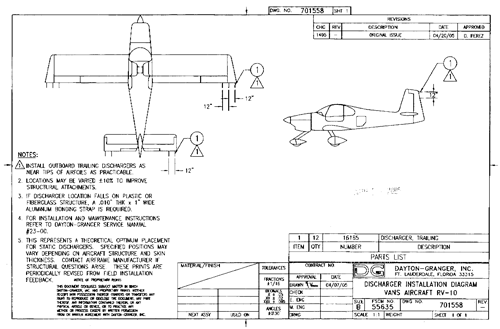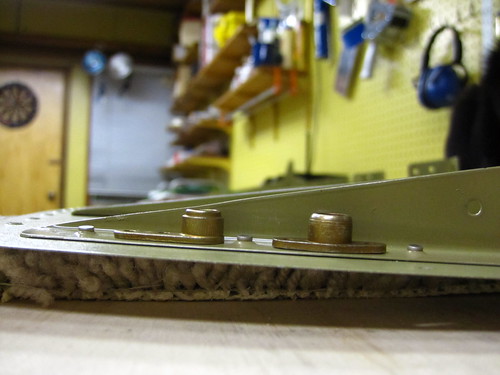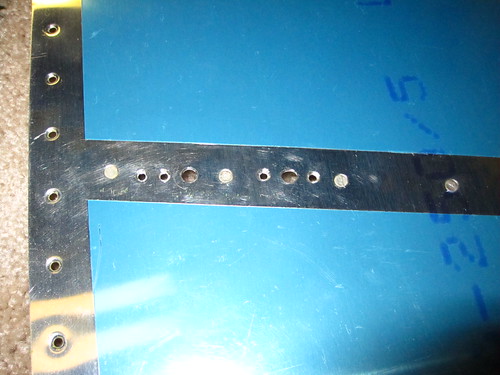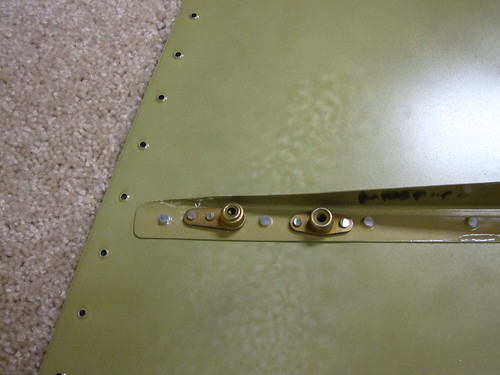
| Workshop | Empennage | Wings | Fuselage | Contact |
Static Wicks for the Rudder
If you decide, as I did, that P-static presents a risk to radio
reception and possibly to the integrity of the moving joints of the
aircraft's control surfaces, then you'll want to install static wicks
and bonding straps. This page covers the installation requires for
static wicks on the rudder of the RV-10. You'll also want them on the
elevators, wingtips, and ailerons—but that will be covered
separately when I get to those stages.
The assembly sequence described here requires that you install some extra hardware before riveting the two sides of the rudder together. I did this installation immediately before buttoning up the rudder and after priming, so that the new holes I drilled would have the best eletrical conductivity when riveted together.

For the rudder, they recommend two wicks. One as close to the top end of the trailing edge as possible, and one twelve inches below that. The 16165 wicks aren't the cheapest; I was able to get them for $42 each at skygeek.com. The recommended loadout for the RV-10 is twelve wicks total, so you're looking at over $500 just for wick hardware. Half go on the empennage and half on the wings, so if you think of it as two $250 purchases separated by quite some time, it's a bit easier to swallow.
I wanted my static wicks to be removable, either for aesthetic reasons when showing off the plane with clean lines, or for replacement if the wicks wear out. Thus, I decided to use screws and locking anchor nuts rather than the usual blind rivet solution. Besides, the holes in the wicks are much too large for any blind rivets I've seen. The holes in the wicks are sized for #10 hardware, so AN515-10 washer-head screws seem like a natural match. For reasons I'll go into in the assembly section, below, the AN515-10R6 is the correct length to get.
A good elastic-insert anchor nut for #10-32 hardware is the AN366F-1032A which I bought from Aircraft Spruce. In order to take advantage of the extremely low headroom environment inside the trailing edge of the rudder, I bought some MS21080-3 one-lug elastic-insert anchor nuts as well for the aft-most screws.
In the RV-10, the underlying stiffeners are almost perfectly suited for the D-G recommendations. The top fairing contributes essentially zero height to the trailing edge, so the top rib's aft-most point is right at the top of the trailing edge. This rib makes a perfect location for the upper wick's attachment hardware.
The second stiffener down from the top is almost exactly 12" below the top rib, and thus it makes an excellent choice for a built-in structural reinforcement for the lower rudder wick.
Since both wicks locations have built-in doublers already, nothing more is required beyond the screws, anchor nuts, a few rivets, and the wick itself. Here is a picture of the anchor nuts sitting in place on the inside surface of the upper rib:

In this position, there is just enough headroom for the aft anchor nut, so the screw has to be sized just right so as not to protrude from the elastic side of the nut when tightened down. The AN515-10R6 is perfect for this. Here is a side view showing how little clearance there is:

Note, however, that both of these pictures were taken with the hardware resting on the right-side skin. In practice, it makes a lot more sense to add the wicks to the left-side skin so that they add a bit to the generally-desireable right rudder effect. I used the right-side skins for testing the anchor nut head room because the stiffener was slightly taller on this side and was a better estimator of the total space available between the skins.
Once the locations for the rivet and screw holes are determined, I recommend making a hole template out of scrap sheet aluminum for the anchor nut hole pattern, then using that to drill the holes in the rudder skin and stiffeners. I didn't do this the first time through and the holes were a bit wonky as a result. Here are the holes for the lower of the two wicks:

And here is the same spot, from the other side, after the anchor nuts were installed:

Note that the rivets for the anchor nuts must be flush or the wick hardware can't sit flat against the skin. Also, the anchor nuts won't accept a dimpled hole. Thus, the skin/stiffener combo must be machine countersunk to accept the rivet. Because of the weird angle of the stiffener beneath the skin, I was not able to do this with my drill press and ended up doing it manually with my deburring tool and countersinking bit, one turn at a time and testing the fit of the rivet. In the end, I got great results. Once this is done for both locations, the wicks themselves can be screwed on for a test.

Once I had confirmed that I was happy with the installation, I removed the wicks and screws and set them aside for the duration of the RV-10 construction project. Won't need to install them again until the plane is ready to fly.
The assembly sequence described here requires that you install some extra hardware before riveting the two sides of the rudder together. I did this installation immediately before buttoning up the rudder and after priming, so that the new holes I drilled would have the best eletrical conductivity when riveted together.
Parts Selection
I selected the Dayton-Granger 16165 static wick part for a couple of reasons. First, they seem to be highly regarded by reviewers on the internet. Second, D-G has published a document showing exactly where and how many of the 16165 wicks are required for the RV-10:
For the rudder, they recommend two wicks. One as close to the top end of the trailing edge as possible, and one twelve inches below that. The 16165 wicks aren't the cheapest; I was able to get them for $42 each at skygeek.com. The recommended loadout for the RV-10 is twelve wicks total, so you're looking at over $500 just for wick hardware. Half go on the empennage and half on the wings, so if you think of it as two $250 purchases separated by quite some time, it's a bit easier to swallow.
I wanted my static wicks to be removable, either for aesthetic reasons when showing off the plane with clean lines, or for replacement if the wicks wear out. Thus, I decided to use screws and locking anchor nuts rather than the usual blind rivet solution. Besides, the holes in the wicks are much too large for any blind rivets I've seen. The holes in the wicks are sized for #10 hardware, so AN515-10 washer-head screws seem like a natural match. For reasons I'll go into in the assembly section, below, the AN515-10R6 is the correct length to get.
A good elastic-insert anchor nut for #10-32 hardware is the AN366F-1032A which I bought from Aircraft Spruce. In order to take advantage of the extremely low headroom environment inside the trailing edge of the rudder, I bought some MS21080-3 one-lug elastic-insert anchor nuts as well for the aft-most screws.
Assembly
The D-G installation diagram for the RV-10 indicates that the top rudder wick should be as close to the top of the trailing edge as possible, and that the lower one should be twelve inches away. It allows for a 10% change in these locations in order to take advantage of the availability of structural mounting positions.In the RV-10, the underlying stiffeners are almost perfectly suited for the D-G recommendations. The top fairing contributes essentially zero height to the trailing edge, so the top rib's aft-most point is right at the top of the trailing edge. This rib makes a perfect location for the upper wick's attachment hardware.
The second stiffener down from the top is almost exactly 12" below the top rib, and thus it makes an excellent choice for a built-in structural reinforcement for the lower rudder wick.
Since both wicks locations have built-in doublers already, nothing more is required beyond the screws, anchor nuts, a few rivets, and the wick itself. Here is a picture of the anchor nuts sitting in place on the inside surface of the upper rib:

In this position, there is just enough headroom for the aft anchor nut, so the screw has to be sized just right so as not to protrude from the elastic side of the nut when tightened down. The AN515-10R6 is perfect for this. Here is a side view showing how little clearance there is:

Note, however, that both of these pictures were taken with the hardware resting on the right-side skin. In practice, it makes a lot more sense to add the wicks to the left-side skin so that they add a bit to the generally-desireable right rudder effect. I used the right-side skins for testing the anchor nut head room because the stiffener was slightly taller on this side and was a better estimator of the total space available between the skins.
Once the locations for the rivet and screw holes are determined, I recommend making a hole template out of scrap sheet aluminum for the anchor nut hole pattern, then using that to drill the holes in the rudder skin and stiffeners. I didn't do this the first time through and the holes were a bit wonky as a result. Here are the holes for the lower of the two wicks:

And here is the same spot, from the other side, after the anchor nuts were installed:

Note that the rivets for the anchor nuts must be flush or the wick hardware can't sit flat against the skin. Also, the anchor nuts won't accept a dimpled hole. Thus, the skin/stiffener combo must be machine countersunk to accept the rivet. Because of the weird angle of the stiffener beneath the skin, I was not able to do this with my drill press and ended up doing it manually with my deburring tool and countersinking bit, one turn at a time and testing the fit of the rivet. In the end, I got great results. Once this is done for both locations, the wicks themselves can be screwed on for a test.

Once I had confirmed that I was happy with the installation, I removed the wicks and screws and set them aside for the duration of the RV-10 construction project. Won't need to install them again until the plane is ready to fly.